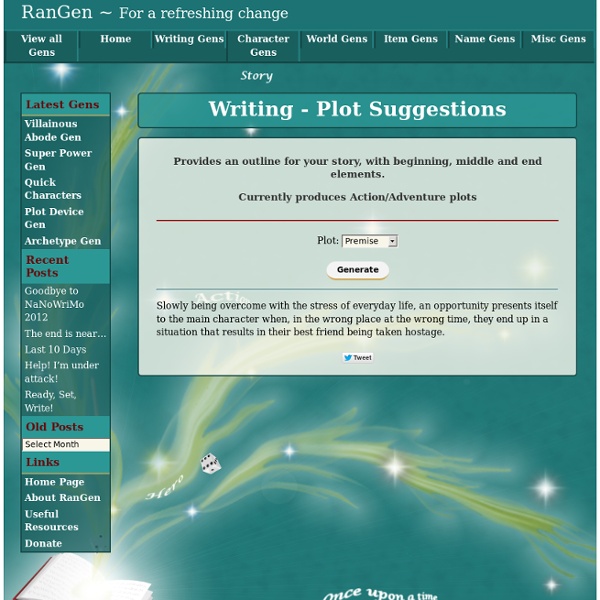



Seventh Sanctum Quick Story Idea Generator Stories The theme of this story: dark quest. The main characters: unbalanced hero and humble secret agent. The theme of this story: light-hearted horror. The theme of this story: metaphorical adventure. The theme of this story: noir slice-of-life. The theme of this story: parody revenge. The theme of this story: serious adventure. The theme of this story: surreal romance. The theme of this story: wacky slice-of-life. The theme of this story: weird revenge. The theme of this story: weird thriller.
Writing Challenge Generator Challenges The story must involve a crown in it. During the story, a character finds out a dark secret. During the story, there is a fight. A character reveals their feelings. A character becomes furious during the story. The story ends during a jailbreak. The story must have a rabbit at the beginning. A character will send a package. During the story, a relative shows up. A character steals something, and the action has far better results than expected. The story must have a navigator in it. During the story, a famous person goes missing.
Fiction University Story Starters: Creative Writing Prompts for Kids If you’re looking to inspire your students’ writing and creativity, turn to these fun and exciting writing prompts. Perfect for overcoming writer’s block or even starting a brand-new short story in a different narrative, creative writing prompts can help students begin a new piece with confidence. Plus, these story starters can also encourage students to explore different genres while honing their writing skills. There are a lot of ways you can use writing prompts in your classroom. Reading a book in a genre, then having students use a story starter in that same genre. Take inspiration from classics like Treasure Island and newer popular series like The Bad Guys to explore how to write thrilling adventure stories. You’re part of a pirate crew in search of a long-lost storied treasure trove. Get students excited about adventure stories with these great books: If you’re looking to inspire your students’ writing and creativity, turn to these fun and exciting writing prompts.
How to Create Good Personalities for Your Characters Edit Article Sample Character DescriptionsCreating Personalities for Your Own Characters Edited by Secretive, Julia Maureen, Flickety, Ben Rubenstein and 19 others You're on a plane to a distant country to visit some weird old relatives you are somehow related to. Ad Steps Sample Character Descriptions Creating Personalities for Your Own Characters 1Start with a simple profile including these categories: Name, Age, Gender, and Occupation. 6Continue developing characters until your story is finished. Tips Keep the characters true to themselves. Warnings Don't copy off other characters in different, already well known books, such as Harry Potter.
Cliche Finder Have you been searching for just the right cliché to use? Are you searching for a cliché using the word "cat" or "day" but haven't been able to come up with one? Just enter any words in the form below, and this search engine will return any clichés which use that phrase... Over 3,300 clichés indexed! What exactly is a cliche? This is Morgan, creator of the Cliche Finder. Or, you might like my crazy passion project: Spanish for Nerds: Learning Spanish via Etymologies! Back to cliches... if you would like to see some other Web sites about clichés? © S. Special thanks to Damien LeriAnd to Mike Senter Morgan's Web page
Questionnaires for Writing Character Profiles - Creative Writing Help Enter your e-mail to get the e-book for FREE. We'll also keep you informed about interesting website news. "I have searched the web and used different worksheets, but none have come close to your worksheets and descriptions of (what to do and what not to do). Both courses I have taken have with Creative Writing Now have been amazing. Each time I have learned something new. The one thing I love, you take everything apart and give examples." - Katlen Skye "As usual - I already love the course on Irresistible Fiction, rewriting a lot and improving greatly even after the first lesson. “Essentials of Fiction proved that I could indeed write and I wrote every day, much to my boyfriend's dismay (waa sniff).” - Jill Gardner "I am loving the course and the peer interaction on the blog is fantastic!!!" "I'm enjoying the weekly email course, Essentials of Poetry Writing. "Thank you for all the material in this course. "Thanks very much for this course. "I'm learning so much. "Thank you so much!!
Wonderbook